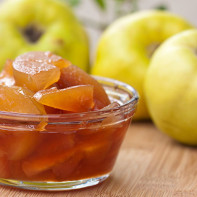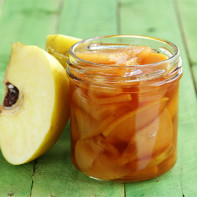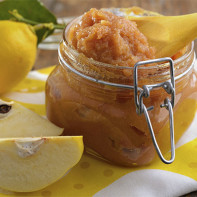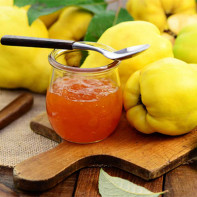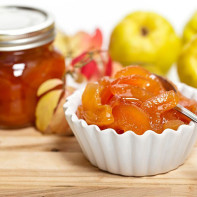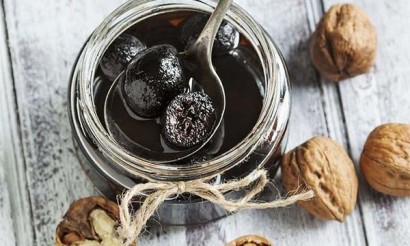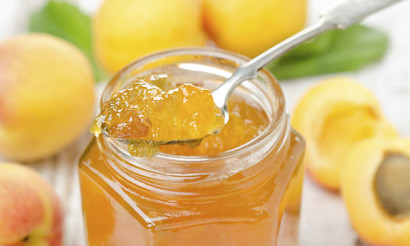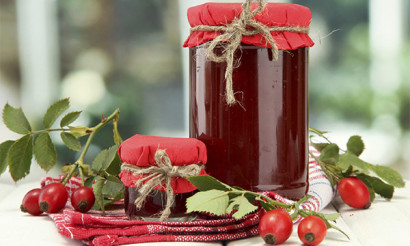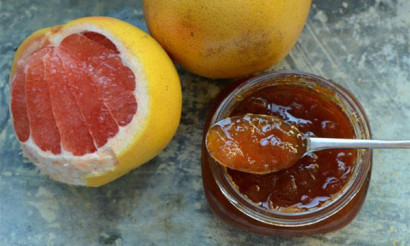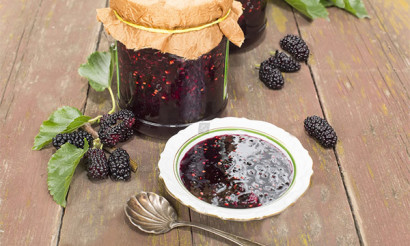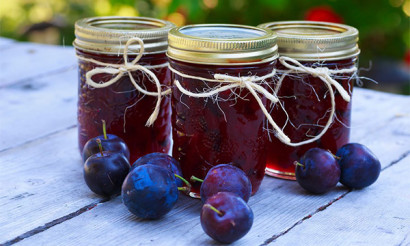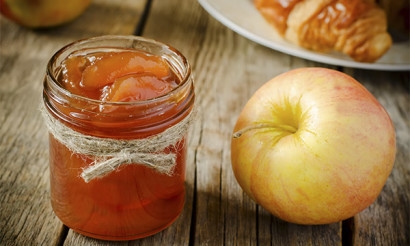Quince Jam: 11 Recipes
Quince has been known for more than four thousand years. Quince fruit is greatly loved and appreciated in the Caucasus, Asia and Eastern countries. In the wild, it bears fruit rarely and tastes very tart and even a bit bitter. But the cultivated varieties are prized in cooking and folk medicine. The oldest species is the Portuguese quince, which was born in ancient Rome. The fragrant but rather tough flesh leaves inexperienced housewives confused. But experienced cooks know that the best way to make her marshmallow, marmalade, compote, and there are about a dozen recipes for jam, and they all taste above all praise.
- What does quince look like
- Useful properties of the plant
- Fruit composition
- What is useful for quince jam
- How to choose a quince for jam
- How to Make Quince Jam: Recipes
- classic
- Walnut
- With lemon
- Apple
- Orange
- Pumpkin
- Grapes
- Cinnamon
- With ginger
- In the multicooker
- In the microwave
- How to store jam properly
- Interesting facts about quince
What a quince looks like
From afar, its fruit can be confused with an apple, especially if they are lying on the counter side by side. But as you get closer, it becomes clear that they are completely different species. Quince has round outlines, the shape is slightly elongated to the stalk. The color of the ripe fruit is gently golden. The skin is covered with soft down, which can easily be rubbed off with a fingertip. The flesh is tough, lightly salted and very fragrant. The taste is astringent and sweet. The ripe fruit can only be tasted in the growing areas. Once their sides have become soft, the fruit should not be transported, as the fermentation process quickly begins in them.
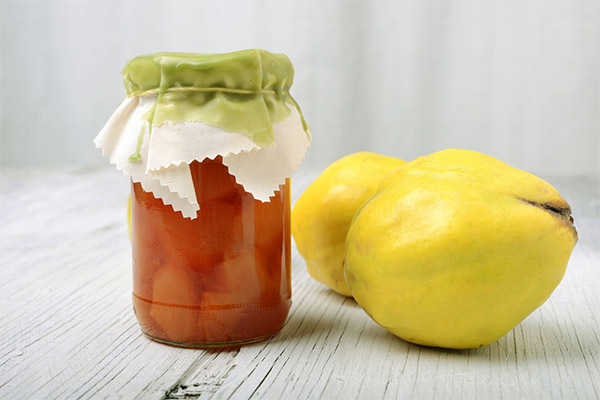
The tree, on which such wonderful fruits ripen, is not tall, grows in almost any soil, is not afraid of frost, drought and high humidity. In natural conditions it prefers the banks of reservoirs, in the Caucasus it is found as part of deciduous forests next to oak, beech, dogwood, rose hips. The drupes have few fruits, they are very small, about 15 g. But as a basis for rootstock, such trees are highly valued for their vitality and unpretentiousness to conditions. Most often they are grafted onto pear trees.
Quince is often found on sale. The season comes in September. There are different varieties in stores and markets, usually coming from the Caucasus, Central Asia and the European part of Russia, including the Astrakhan region.
Useful properties of the plant
Valuable qualities have not only fruits. Leaves and seeds are used in folk medicine recipes. The green mass is gathered and harvested in June and July. Seeds should be taken only from fully ripe fruit. The main effect of leaves and pulp:
- diuretic;
- tonic;
- antibacterial;
- antiviral;
- styptic;
- astringent.
Seeds are used as an enveloping agent, used for intractable coughs, chronic constipation, irritation of the mucosa of the stomach and esophagus.
If the leaves and shifts in the process of harvesting are dried, the pulp in this form is not stored. It is processed according to various recipes, the more so that with a brief heat treatment, most of the useful substances are preserved.
Fruit composition
Those who have a risk of avitaminosis, anemia, low immunity, gastrointestinal diseases should pay close attention to quince. It contains:
- Vitamins C, E, K, PP, group B;
- calcium;
- phosphorus;
- iron;
- magnesium;
- potassium;
- tannins;
- essential oil;
- fructose;
- gum;
- organic acids.
Interesting: The ratio of elements depends on the variety and location of the plant.
The caloric value of 100 g of fresh pulp is low, in the range of 40 kcal. But in this form it is almost not eaten. Further caloric values depend on the method of cooking. The fruit is stewed, baked, boiled, used as an ingredient in sauces.
What is useful for quince jam
It preserves most of the original properties. The level of vitamins decreases because some of them decompose during cooking, but the remaining amount is enough to provide immune support, stabilize the intestines, and prevent viral diseases. The astringent effect remains unchanged, so a few teaspoons will be good for diarrhea, but only after the acute period has passed.
Quince jam along with raspberry jam is used as an antipyretic, its diuretic effect is useful for high blood pressure and cystitis. Fiber acts as a natural abrasive, speeding up the cleansing of the body of toxins.
How to choose a quince for jam
On the quality of the fruit will depend on the taste of the finished product and its shelf life. With the beginning of the season there are many quinces, the fruits differ in shape, size, taste, but the main signs of a ripe fruit are the same:
- Firm to the touch;
- coloring is uniform, without green stripes and dark spots;
- The surface is covered with a soft fluffy layer;
- flavor is strong, persistent, without sour tones;
- absence of mechanical damage to the skin.
Worth considering: It is better to choose large fruits, they have a longer shelf life and taste better.
How to make quince jam: recipes
When cooked, it looks very beautiful - transparent, soaked in sun droplets and slightly glowing with pinkish reflections, with even, uncooked slices of fruit. Quince combines well with nuts, a number of fruits and citrus fruits. It is brewed in different ways, with only one kind of fruit or with the addition of additional ingredients.

Classic
Includes only slices of fruit and sugar in equal proportions. If the pulp is too dry, it is allowed to add a small amount of water during cooking. Despite the fact that quince is tough, it is as boiled as the rest of the fruit. Of the initial amount of products in the cooking will remain only half due to evaporation of liquid. So, buying a kilogram of fruit, you need to prepare a half-liter jar for twisting.
Washed fruits are cut into slices, take out the core with seeds. To cook evenly, cut quinces in thin slices. Then they will be translucent in the syrup, tender, well soaked in syrup and will not decompose. There are three ways to make jam.
- With aging. Pieces of fruit in layers pour half the rate of sugar and leave for a day. Then the rest is added, stirred and boiled over low heat until the pieces soften. When boiling, the jam is poured into jars and sealed with lids. You can use an airtight seal.
- Without storing. First, boil a syrup of sugar and water in the proportion of 1 kg per 200 ml of liquid. Then in the boiling mass gently put chopped slices and cook with constant stirring until soft, and then placed in jars. For jam to store well, the syrup should completely cover the fruit.
- Triple. Filled with sugar, the fruit is kept for a day, then the syrup is drained, brought to a boil and pour the fruit. After 12 hours, the procedure is repeated. For the third time, boil the whole mass until the pieces of fruit become soft, roll it up in jars.
The jam turns out pinkish, transparent, with a rich flavor and a slightly tart pleasant taste.
With walnuts
To the walnuts in honey, sold at fairs and exhibitions of beekeeping, have already become accustomed. Quince and walnuts look no less dressy and festive. Boiled according to all the rules of exquisite jam will be a delicious gift for a loved one. You will need 2 kg of fruit and the same amount of sugar, 200 grams of walnut kernels, 400 ml of water, 1/4 tsp. vanilla or a bag of vanilla sugar.
This recipe uses fruit, peeled from the skin and core. They are cut into slices and set aside under a lid or towel. Peels and cores put in a saucepan, pour 2 cups of water and simmer for 10 minutes over low heat. The resulting liquid is used for further cooking. Put the fruit slices in it and leave the stove for 6-10 hours to soak.
Then nuts and vanilla are added to the mass and cooked on minimal heat for 45 minutes. The ready dainty is distributed in jars. Store in a cool cellar or at room temperature.
With lemon
The tart taste of quince is beautifully set off by the lemon sourness. In addition, the acid shortens the cooking time by softening the fruit much faster. You will need the same amount of fruit and lemon juice for 1 kg of sugar. The essence is to boil the mass for a short time, alternating with periods of infusion. The whole process will take 2 days, the active time is 15 minutes.
Sliced quince slices are filled with sugar and left until the juice is released. Usually 2-3 hours is enough. Then add water, boil over low heat for 5 minutes and remove from the fire. Mass stand for 12 hours. Requires two approaches. On the third, add the lemon, boil for another 5 minutes with constant stirring, and in the hot form is packed in containers for storage.
Lemon can be cut into thin slices, put through a blender or just squeeze the juice.
With apples
A very spectacular looking and tasty recipe without too much complexity. In some countries, quince is called the golden apple. It goes well with the winter varieties in taste. They are just as hard and do not reveal their flavor immediately after picking from the branches, but give all the flavor in a two-component jam. The delicacy is made according to a classic recipe with aging for the initial production of juice.
With orange
The combination of citrus and quince gives a tangy flavor and a charming golden color.
Interesting: In the refrigerator, ready-made jam with orange thickens.
For 2 kg of fruit, you need an equal amount of granulated sugar and 1 large ripe orange. First, the main ingredient is poured sugar in an amount of 1/2 of the norm and incubated for 2-4 hours until the juice, boiled for 20 minutes. Then drain the liquid, add the remaining sugar and bring the mixture to a boil, stirring until the crystals dissolve completely. Pour it on sliced quinces and leave until it cools. Add cubes of orange without zest to the fruit mass and cook the jam for another 35 minutes. It is best to pour the delicacy into jars of small volume. Open, it quickly loses some of the flavor.
With pumpkin
For 2 kg of slices of fruit take 800 g of pumpkin and 2.5 kg of sugar. You can boil both with ageing and separate boiling of the juice, and a triple five-minute jam with a stand-up of 12 hours each. If you plan to store the finished product in a cool place, the sugar rate can be reduced by 500 g.
First boil the quince, at the second boil add the melon crop, sliced or diced. Slices of both ingredients boil better if they are about the same thickness. The jam turns out rich, with a mild taste, as pumpkin absorbs and neutralizes the tart flavor of the golden apple.
With grapes
The sunny bunches hide a large supply of fruit sugars. In ancient Rome, many delicacies were brewed with grape juice, and this quality can be advantageously used in the preparation of the mix with quince. The mixture is brewed in one sitting, provided that the pieces of fruit are chopped finely and thinly. Grape berries are used whole, removing only the twigs. Calculation by weight:
- quince - 680 g in peeled form;
- grapes - 450 g;
- sugar - 1 kg;
- water - 100 ml.
The mass is boiled in a bowl with a thick bottom with constant stirring. The ingredients are put at the same time. First heat the mixture quickly, after boiling turn the heat down to a minimum and keep at a constant temperature for 1.5 hours. Some grape varieties produce a copious foam, which must be removed as it appears. Once the pan is removed from the stove, the hot mixture is distributed into jars and sealed hermetically. Store only in a cool place or on the bottom shelf of the refrigerator.
With cinnamon
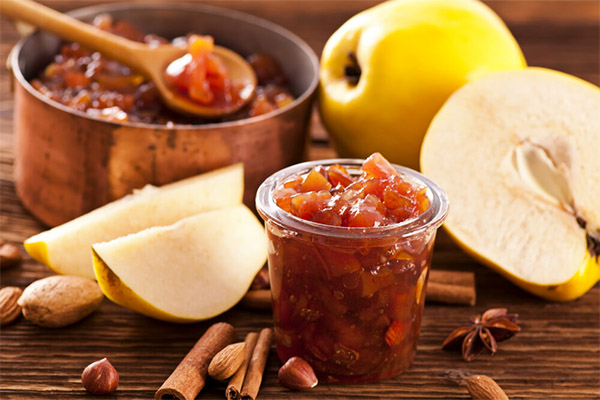
In the homeland of quince spices are in reverence. In ancient times they were very expensive, for 1 g in the market were given ten times the weight of gold. Nowadays you can buy any spice in a regular store. But to make quince jam, it is better to visit a shop of Indian spices and buy cinnamon sticks. You need 0.5 teaspoon of spice. You can grind it in a coffee grinder or put it whole. The textured cinnamon sticks will look interesting in a jar of jam. There is no need to take them out before pouring the finished product, the cinnamon will give off its flavor and aroma as it cools.
Proportions:
- slices of fruit - 1 kg;
- sugar - 700 gr;
- water - 400 ml.
In some variants it is allowed to add the juice of half a large lemon at the end of cooking to remove excessive sweetness and increase the shelf life of the product.
With ginger
The benefit of this aromatic root is to give dishes a spicy taste. Ginger is used as an anti-inflammatory, antibacterial agent. It boosts the immune system, prevents avitaminosis, blocks the development of pathogenic bacteria. In combination with quince jam acquires healing properties, helping to withstand the period of epidemics of influenza and acute respiratory infections.
As an ingredient of the treat, it is added at the rate of 50 g per 700 g of fruit and the same amount of granulated sugar. For cooking, only fresh root is taken. In a saucepan pour half a glass of water, pour sugar and stir until boiling. In the syrup is lowered fruit and spices, cut into thin slices. Boil continuously on low heat with constant stirring for 1 hour, after which the mass is placed in sterilized jars and closed for the winter or until the first guests.
In a multicooker
The advantages of this type of household appliances in a special bowl, which does not allow the dish to stick. It turns out to be an economy of effort and time, as the jam is cooked, but there is no need to stand over it. Its taste qualities are not inferior to jam cooked the classical way in a pot.
To prepare it, take an equal amount of sugar and fruit, 200 ml of water, 1/4 tsp. citric acid. The ingredients are put in at the same time, put on stew mode for an hour. Some housewives recommend opening the multicooker every quarter of an hour and stir the mass with a wooden spoon. But with the right ratio of ingredients, this will not be necessary, especially if you apply a delayed start, letting the pieces of fruit juice to increase the amount of liquid.
In the microwave
Cooking time for any dish in it is reduced by several times. Another thing is that you will still have to take the container out of the chamber, so that the mass has settled down. At one time to boil a delicacy will not work.
Shred the fruit slices finely, so that they are quickly soaked in syrup. In the first stage, the fruit slices are poured with water, added sugar and put for 12 minutes at 80% power. The proportions:
- quince - 0.5 kg;
- sugar - 0.5 kg;
- water - 100 ml.
It is worth considering: The volume of a single portion of jam in the microwave will turn out to be small.
After the time on the timer is over, the container is taken out on a wooden stand and left until the mass cools completely. It is desirable to cover it with a lid. It takes three approaches, during the last one you can add a little lemon juice or do with just the basic ingredients.
How to store jam properly
If you follow the technology of cooking, tightly sealed jars are put in a cool corridor, on a warmed loggia or leave on a shelf in the pantry at room temperature.
The exception is a treat on grape juice or with whole berries. Its increased tendency to ferment when stored in heat can give the lid a bloat. It is more reliable to eat the treat immediately after making it or store it in the refrigerator on a vegetable shelf.
Interesting facts about quinces
Like every plant, the golden apple has its little secrets:
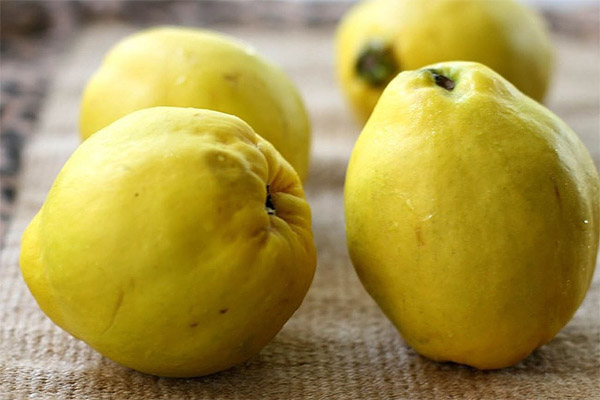
- Turkey is recognized as the leader in cultivation of the fruit, with exports accounting for 5 percent of the total by country.
- There is only 1 species in the genus, there are no more related to it.
- In the wild version, the tree bears fruit sparingly, with 3-7, maximum 10 small, tart fruits, weighing up to 100 g, ripening on the branches.
- The largest fruits of some varieties reach a weight of 2 kg.
- The plant was cultivated about 4 thousand years ago, breeding work does not stop, regularly appear new varieties adapted to more northern regions.
- In ancient times, the plant was dedicated to Venus and planted near her temples.
- The oldest variety is the Portuguese quince.
- A number of trees are used as hedges, but require regular pruning and crown formation.
Quince jam has long been a popular treat in eastern countries. In the middle latitudes, it grows in the Volga region, the Caucasus and Krasnodar Krai. Buying fragrant fruits, it is worth giving preference to domestic species. They contain a little less sugar, but do not go to the shelves halfway around the world, treated with chemicals for preservation.
In season fruit is inexpensive, and in September it's a good time to set aside 1-2 days to make an amazing treat full of vitamins and good cheer.
«Important: All information on this site is provided for informational purposes only for information purposes only. Before using any recommendations, you should consult a health care professional. specialist before using any of the recommendations. Neither the editors nor the authors shall be liable for any possible harm caused by materials."

